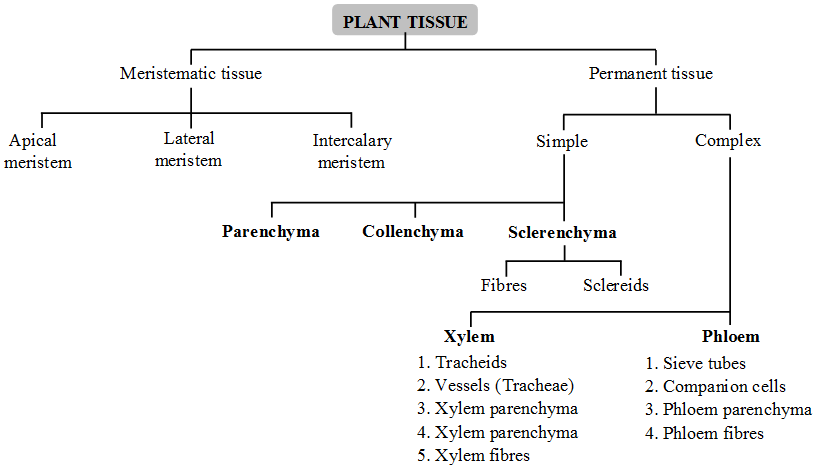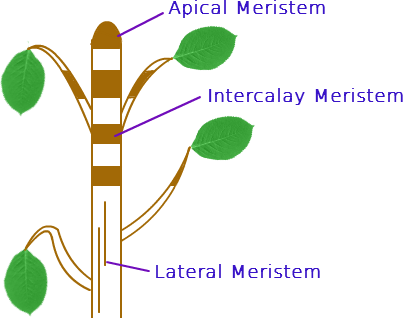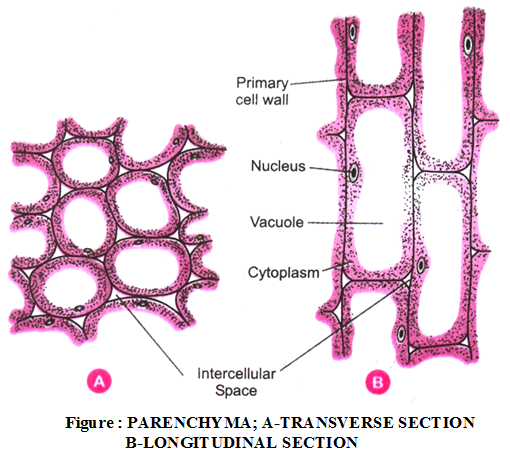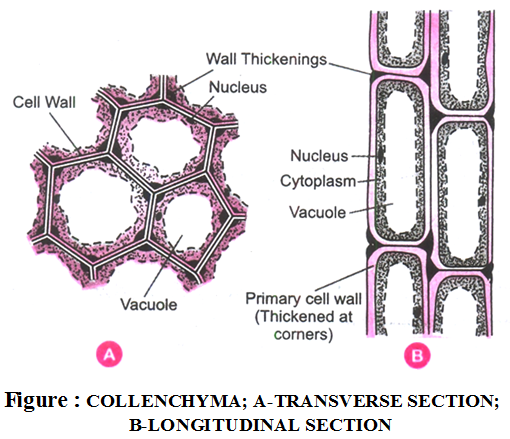What are the types of plant tissues and their functions
“A tissues may be defined as a group or collection of similar or dissimilar cells that perform a common function & have a common origin.”
Classification of Plant Tissues :

A plant body is made up of different kinds of tissue. They are basically of two types – Meristamatic & permanent
Meristematic tissue :
Meristematic tissues may be defined as a group or collection of living cells which ar located specific locations and divide continuously to add new cells to the plant body.
Characteristics of meristematic tissues :
- The cells of meristematic tissues are similar in structure and have thin and elastic primary cell walls made up of cellulose.
- These meristematic cells may be rounded, oval, polygonal or rectangular in shape.
- They are compactly arranged without intercellular spaces between them.
- Each cell contains dense or abundant cytoplasm and a large prominent nucleus.
- The dense protoplasm of meristematic cell contains few small vacuoles or no vacuoles at all.
1. Apical meristem :
This meristem is located at the growing apices of main and lateral shoots and roots. These cells are responsible for linear growth of an organ. Example root apical meristem and shoot apical meristem.
2. Lateral meristem :
This meristem consists of initials which divide mainly in one plane and cause the organ to increase in diameter and girth. The lateral meristem usually occurs on the sides both in stem and root. Lateral meristem is of two types, i.e., in the form of cork cambium and in vascular bundles of dicots in the form of vascular cambium. The activity of this cambium results in the formation of secondary growth.
3. Intercalary meristem :
This meristem is located in between the regions of permanent tissues. The intercalary meristem are usually persent at the base of node, base of internode or at the base of the leaf. They are responsible for growth of leaves and internodes.

Permanent Tissues :
These tissues are derived from the meristematic tissues but their cells have lost the ability of division and have attained their different forms.
They are of these types-Simple and Complex.
Simple Permanent Tissues :
These tissues are made up of cells which are structurally and functionally similar. These are of three types –
- Parenchyma
- Collenchyma
- Sclerenchyma
1. Parenchyma :

- The parenchyma tissue is composed of living cells which are variable in thin morphology and physiology but generally having thin wall and a polyhedral shape and concern with vegetative activities of the plant.
- They have inter cellular spaces between them.
- They act as storage for food and water.
Types of Parenchyma :
- Aerenchyma :
- In hydrophytes, the intercellular space between cells become wide & filled with air.
- Such a parenchymatous tissue having large air spaces is called Aerenchyma.
- These help in gaseous exchange and provide buoyancy to plant.
- Chlorenchyma :
- When parenchyma is richly supplied with chloroplasts, it is called chlorenchyma.
- They are found in leaf mesophyll, sepals, phylloclades, phyllodes, cladodes etc. It is photosynthetic in function and posses chlorophyll.
2. Collenchyma :
- It was discovered and coined by schleiden (1839).
- The cells are living with intercellular space in between the cells or junctional places filled with cellulose and pectin.
- Generally they are longer than parenchyma
- Usually they are known as living mechanical tissue owing to their supportive functions.
- It provides flexibility and strength to young plant organ.
3. Sclerenchyma :

- They were discovered and coined by Mettenius (1805).
- The cells are long, narrow, pointed at ends, thick walled and lignified. They are the dead cells.
- It impart hardness to plant parts and give mechanical strength.
Complex permanent tissues :
Complex tissues are of following two types.They are Xylem and Phloem
Xylem :
Its main function is conduction of water and mineral salts from root to the top of plant.Primary xylem elements originate from procambuim of apical meristem.Secondary xylem elements originate from the vascular cambium of lateral meristem.
The xylem elements are of 4 types : xylem tracheids, vessels, fibers and parenchyma.
- Xylem Tracheids :
- These are lignified and dead cells with bordered pits.
- They help in conduction of water in pteridophytes and gymnosperms and provide mechanical support plants.
- Xylem Vessels :
- The cells are long and tubular with lignified cell wall.
- The cross wall (end wall) at both the ends dissolves and form a pipe like channel.
- They help in ascent of sap in angiosperms.
- Xylem Fibers :
- Long and narrow sclerenchymatous fibers with tapering end. The wall is heavily lignified leaving a very narrow Lumen.
- It provides tensile strength and mechanical strength.
- Xylem Parenchyma :
- They are thin walled living cells present in both primary and secondary xylem.
They store food materials.
- They are thin walled living cells present in both primary and secondary xylem.
Phloem :
The dead matter in them is known as bast.Its main function is conduction of food material from leaves to other plant parts.
The phloem elements are of four type : Sieve tubes, Companion cells, Fibres and paranchyma.
- Sieve Tubes :
- These are living but lack nucleus at maturity.
- Cell wall is thin and made up of cellulose.
- The transverse walls of sieve tube form sieve plate.
- They help in conduction of food material.
- Companion Cells :
- The cells are living, thin walled, narrow and found attached to the lateral side of sieve element.
- They are absent in pteridophytes and gymnosperms.
- They support the sieve tube in transport of food.
- These are living and thin walled cells.
- They are absent all monocots and some dicots.
- Phloem Fibers (bast fibers) :
- These are sclerenchymatous fibers having thick wall and narrow Luman.
- They provide mechanical support to the plant.
- Phloem Parenchyma
- The chief function of parenchyma is to store food material and other substances like mucilage, tanins and resins.
Protective Tissue :
It includes epidermis and cork.
- Epidermis :
- It is usually present in the outermost layer of the plant body such as leaves, flowers, stem and roots.
- Epidermis is one cell thick and is covered with cuticle.
- Cuticle is a water proof layer of a waxy substance called cutin which is secreted by epidermal cells.
- The main function of epidermis is to protect the plant from desication and infection.
- Cork :
- As roots and stem grow older with time (increase in girth), tissues at the periphery become cork cell.
- Cork cells are dead cells and they do not have any intercellular spaces.
- The walls of cork cells are heavily thickened by the deposition of an organic substance
(a fatty substance), called suberin. - Cork is protective in function. cork cells prevent desiccation (loss of water from plant body), infection and mechanical injury.
- Cork is produced by cork cambium commereially it is obtained from oak (quercus suber).
- Cork is used for making insulation boards, sports goods, bottle corks etc.
Stomata :
Epidermis of a leaf is not continuous at some places due to the presence of small pores, called stomata.
Each stomata is bounded by a pair of specialised epidermal cells called guard cells.The stomata allows gaseous exchange to occur during photosynthesis and respiration.
Structure of Stomata :

Opening & Closing of Stomata :
- Stomata opens in presence of light, at high temperature & at low CO2 concentration.
- When guard cells becomes turgid stomatal pore opens, while when they becomes flaccid stomatal pore closes.
- Due to endo-osmosis guard cells becomes turgid while due to exo-osmosis guard cells becomes flaccid.
- Due to increase in the amount of osmotically active sugars in guard cells, their osmotic pressure increases and water enters inside the cells increasing the turgidity of cells and hence stomata opens.
- When amount of sugar decreases, stomata closes. Several theories have been proposed by the scientist to explain the opening and closing of stomata.